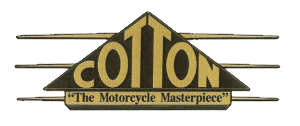



1923
Model 1 - 2¼ h.p. Blackburne
Model 3 - 2½ h.p. Villiers
Model 5 - 2¾ h.p. Blackburne 2 Speed
Model 6 - 2¾ h.p. Blackburne 3 Speed
Model 7 - 2¾ h.p. Blackburne 3 Speed
Model 9 - 2¾ h.p. Blackburne OHV 3 Speed
Model 11 - 2¼ h.p. Blackburne OHV 3 Speed
1925
SV Models
Model 1 - 2.5 h.p. 249cc Blackburne SV
Model 5 - 3.5 h.p. JAP 350cc SV 3 Speed
Model 7 - 3.5 h.p. Blackburne 348cc SV 3 Speed
Model 8 - 5.5 h.p. Blackburne 550cc SV 3 Speed
OHV Models
Model 29 - 3.5 hp 348cc Blackburne
Model 9 - 3.5 hp 348cc Blackburne
Model 30 - 2.5 hp 249cc Blackburne
Model 11 - 2.5 hp 249cc Blackburne
1928
Two-stroke Model
Model 3 - Villiers 343cc
OHV Models
Model 9 - Blackburne 348cc
Model 29 - Blackburne 348cc Twin-port
Model 5 - Blackburne 496cc
Model 25 - Blackburne 496cc Twin-port
Model 9 - JAP
Model 29 - JAP Twin-port
Model 5 - JAP
SV Models
Model 7J - JAP 348cc
Model 7 - Blackburne 348cc
Model 8 - Blackburne 496cc
1931
Model 11/J JAP 245cc
Model 29/J JAP 345cc
Model 25/J JAP 49cc
Model 29/RP Python 4 Valve 349cc
Model 25/RP Python 4 Valve 499cc
Model 9/OSF Blackburne 348cc
Model 29/B Blackburne 348cc 2-port
Model 25/B Blackburne 496cc 2-port
Model 25/SA Sturmey-Archer 496cc 2-port
1935
Advertising for the 1935 range boasted "16 Superlative Models" and that Cotton had gained 3 first places at the IOM TT, 4 seconds and 3 thirds.
OHV Models
Model 9/JC - 349cc JAP
Model 9/J - 349cc JAP 2-port
Model 29/J - 349cc JAP
Model 29/B - 349cc Blackburne
Model 25/J - 490cc JAP
Model 25/B - 496cc Blackburne
Model 26/J - 596cc JAP
Model 26/B - 596cc Blackburne
OHV 250cc Models
Model 6/J - 249cc JAP OHV
Model 30/J - 249cc JAP OHV Twin-port
Model 6/B - 249cc Blackburne OHV
SV, Two-stroke and 150cc OHV Models
Model 1/V - 150cc Villiers
Model 1/J - 150cc OHV JAP
Model 1/B - 150cc OHV Blackburne
Model 2/JC - 250cc SV JAP
Model 2/J - 250cc SV JAP
1936
A range of 17 models was offered, 150cc to 600cc.
These included a 250cc SV, a 250cc OHV, and a 500cc OHV Super-sports.
1937
14 models were released for 1937 including:
250cc SV
250cc OHV
350cc OHV
500cc OHV
600cc OHV
1938
Model 9/38 - 350cc OHV JAP
Model 350/38 - 350cc OHV JAP
Model 9/Special - 350cc OHV JAP High-cam
Model 500/38 - 500cc OHV JAP
Model 5/Special - 500cc OHV JAP
Model 25/Special - 500cc OHV JAP High-cam
Model 600/38 - 600cc OHV JAP
250cc Models
Model 6/B - 249cc OHV Blackburne
Model 250/3S - 249cc OHV JAP
Model 30/Special - 249cc OHV JAP
Lightweights
Model 1/V - 150cc Villiers Two-stroke
Model 1/B - 150cc OHV Blackburne
Model 2/JC - 250cc SV JAP
Model 2/J - 250cc SV JAP
1939
A range of 14 models was offered, 150cc to 600cc.
350cc OHV
500cc OHV
600cc OHV
1941
A correspondent wrote that he has a 1941 model with a Villiers 9d engine, and that the original registration documents give a date of September 1941. He says that it was most likely made just before the war and registered some time later.
1951
A flyer suggests that the 1951 range was much the same as the 1939 offerings. Prices were changed, and several models were unpriced. The 600 OHV machine was changed to sidevalve.
Models without prices were 500/39 Standard, 600/39 Standard, 250/39 Standard, 350/39 Standard, and Model 2/JC.
1955
In 1955 the Cotton Cotanza appeared, powered by a 242cc Anzani engine and sporting a new frame with "pivoted-fork" rear suspension. The same frame was used in an updated 1955 Vulcan fitted with a 3-speed Villiers 9E engine.
1956
The Vulcan was fitted with a four speed gearbox, and another Cotanza appeared with a 322cc Anzani twin engine. A Cotton Trials was added to the catalogue, basically a Vulcan with road fittings and lights removed. The Vulcan was no longer listed.
1957
A Villiers two-stroke twin was added to the Cotanza range. The K.C.1 Vulcan 197cc Villiers remained, along with the 197cc Trials model.
1958
No change to the 1957 range.
1959
All models were fitted with Armstrong leading link forks, and the Villiers 2T twin was dropped.
New models for 1959-1960 were the Herald, Messenger, Double Gloucester, Continental, Corsair and Conquest.
The Conquest had a Villiers 247cc Starmaker engine, dual seat, Armstrong leading link forks, Armstrong rear dampers, 7" front brake, 12v lighting, 120 m.p.h speedometer, 3 gal. tank and weighed 260lbs.
A range of road-racing, trials and scrambler models had all been added to the catalogue by the end of 1960.
1961 range
The range consisted of eleven models including the Vulcan 4-speed 197cc in Road or Sports,
250cc Cougar Scrambler, the Corsair 246cc Villiers 31A, and the Continental duplex frame 250cc. There were also roadsters named Double Gloster and Herald Twin, and the 324cc Messenger twin.
Villiers engines powered all models.
The Cougar was campaigned by the factory which fielded Brian Goss, John Draper and other riders. It had a Villiers 34A 246cc engine, leading link forks, and 6" British Hub brakes.
1962
The Villiers Starmaker 247cc racing engine had become available and was fitted to Telstar road-racers and Conquest production models.
Derek Minter won the 1964 British 250cc championship on Telstar, racing for the Cotton factory.
Some 60 of these were built, along with 185 of the road-going version introduced in 1964, the Conquest. Production of the Conquest ceased in 1967.
1963
A Trials model was available with a Villiers 31A 250cc engine and leading link forks. Colour schemes were black with red, scarlet, bronze or dark blue.
1965
Cotton Cossack Scrambler - 247cc Villiers Starmaker MkII, Metal Profile or Ceriani forks, Girling rear dampers.
1968
When Villiers ceased supplying engines Cotton began fitting Minarelli units to their off-road machines. Rob Edwards won the 200 class of the 1969 Scottish on the new Cavalier 175cc Trials model.
1970
The factory moved to Stratton Road. Production of the Cotton Sturdy three wheel utility vehicle commenced.
1970-1980
The factory moved again, and a new 250cc competition machine appeared fitted with a Rotax engine, as Villiers had ceased production. The Rotax was good, but there was fierce competition from the Japanese in both price and performance.
Production of the Cavalier 175T continued, with an updated version available in 1972, and a new trials machine named the Javelin appeared a few years later powered by engines produced by DMW, who had bought the Villiers jigs.